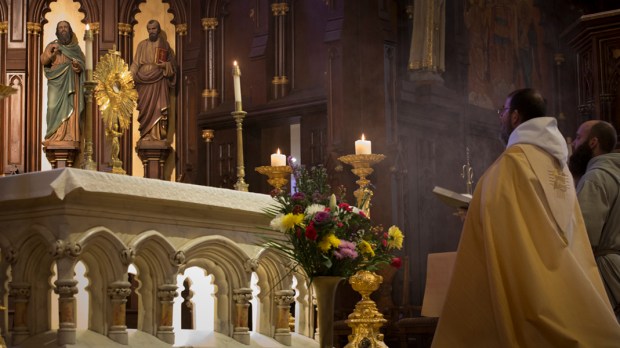Back in 1995 the American theologian Germain Grisez and I published an article noting with dismay poll data showing that a very large number of self-identified Catholics in the United States believed that Christ’s presence in the Blessed Sacrament was only “symbolic,” rather than a Real Presence as the Church clearly and firmly taught.
Earlier this month, the Pew research center published, without visible dismay, poll data showing a very large number of self-identified Catholics in the United States believe Christ’s presence in the Blessed Sacrament is only “symbolic,” rather than a Real Presence as the Church clearly and firmly teaches.
Much has changed since 1995, but one thing that’s evidently the same is the troubling gap between what Catholics believe about the Blessed Sacrament and what the Church teaches. To be precise, 69% of the Catholics in the Pew study said the consecrated bread and wine in Mass are “symbols of the body and blood of Jesus Christ” rather than Christ himself. The other 31% believe in the Real Presence.
Looking at the numbers, I recalled that, according to the Center for Applied Research in the Apostolate, 21% of American Catholics now go to Mass every Sunday. It’s reasonable to suppose that most of that group attend Mass weekly because, among other things, they believe in the Real Presence. As for the 10% who believe but don’t attend weekly, these are the wobbly faithful whose practice of their religion is wanting but whose less than perfect faith makes them appropriate subjects for prayer that they will pull up their socks and get serious.
And what of that alarmingly large group — 69% of self-identified Catholics — who don’t believe in the Real Presence and seldom or never go to Mass? They need our prayers too, but possibly in their case it would be a good idea to throw in fasting and a few other penitential acts.
Disbelief in the Real Presence is, however, hardly new. In fact, you find it clearly at work in the sixth chapter of John’s gospel in the reactions to Jesus’ Eucharistic Discourse.
The setting is the synagogue in Capernaum. It is only a few days since Jesus performed one of his most striking miracles, the multiplication of loaves and fishes, which brought the crowd flocking after him eager to make him king. Instead, Jesus stuns them by speaking of the Bread of Life: “He who eats my flesh and drinks my blood has eternal life … my flesh is food indeed, and my blood is drink indeed.”
The response of many of the listeners is consternation followed by utter disbelief. Even some who had been Jesus’ disciples up to then turn away and leave him. And at this low point comes what, for me, is perhaps the strongest testimony to the literal fact of the Real Presence.
Faced with doubt, disbelief, and outright rejection, Jesus might have backtracked and said he was just using a figure of speech — the bread and wine he spoke of were only symbols of his presence. If, however, what he said earlier was literally true — if his Real Presence in the Blessed Sacrament was to be really real — saying otherwise now was out of the question. Rather than do that, Jesus doubles down on his message, declaring: “The words that I have spoken to you are spirit and life.” Then, determined to have no doubters among his followers, he turns to the Apostles and asks them, “Will you also go away?”
The gospels contain many instances of Peter failing to measure up. But this time he rose fully to the occasion: “Lord, to whom shall we go? You have the words of eternal life.”
Perhaps we should take St. Peter as our intercessor when we pray that belief in the Real Presence of Christ in the Blessed Sacrament will be strengthened in our brothers and sisters in the faith if it is weak and restored to them if it has been lost.

